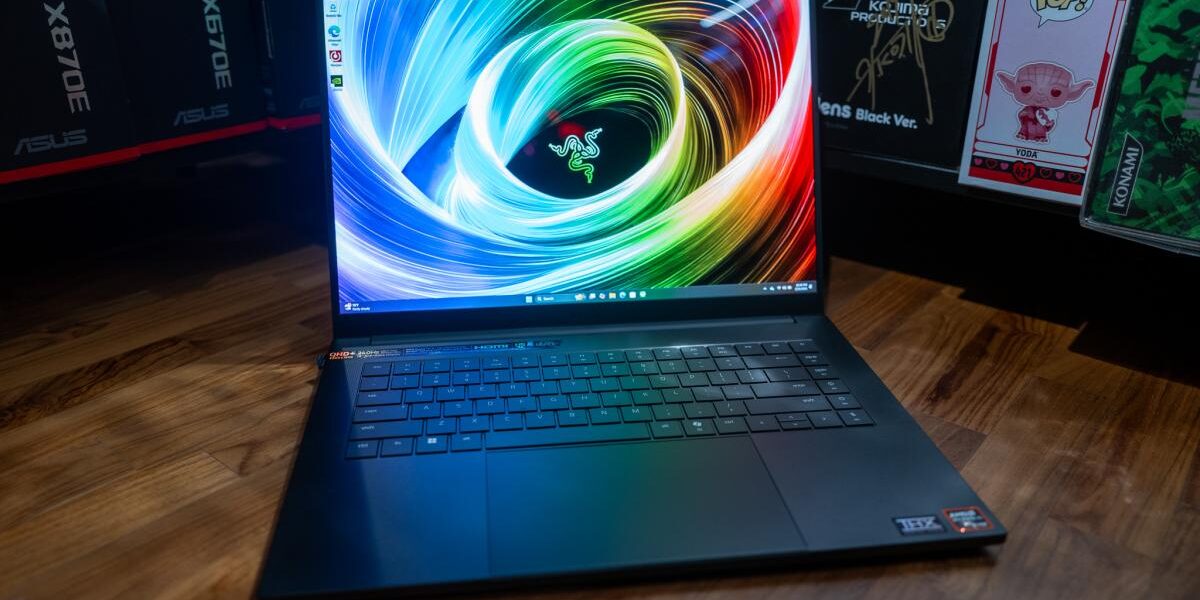Razer Blade 16 (2025) performance impressions: NVIDIA’s RTX 5090 has arrived for gaming laptops
Razer Blade 16 (2025) performance review: NVIDIA’s RTX 5090 has arrived for gaming laptops
Note: This review was first published on 1 April 2025.

(This article was first published on 28 March, 2025. It has been republished to coincide with the availability of RTX 50 Series gaming laptops starting from 31 March, 2025.)
NVIDIA certainly isn’t wasting time with its latest gaming GPUs, the GeForce RTX 50 Series. Officially announced at CES 2025 and launched in January beginning with the GeForce RTX 5090 (read review here) cards for desktop PCs, the Blackwell-based GPUs have now finally arrived inside gaming laptops.
It’s no secret that the higher-end GeForce RTX 50 Series graphics cards have not been easy to buy due to scarcity (not to mention the high mark-ups in prices because of it), but gaming laptops powered with the new mobile GPUs are set to go on sale starting from 31 March, from usual brands such as ASUS ROG, Gigabyte and Razer. As with its desktop cousins, laptops outfitted with the RTX 5090, 5080 and 5070 Ti GPUs will launch first, followed by the RTX 5070 in late April onwards.
To size up the new mobile GPU’s performance, NVIDIA sent over a spanking-new Razer Blade 16 (2025) that’s powered by the GeForce RTX 5090 Laptop GPU. My focus here is very much on the new flagship laptop GPU’s performance, but you can also find out more about my thoughts on the Razer Blade 16 laptop in my earlier impressions (read here). TL;DR, the latest Razer Blade 16 doesn’t stray away from the familiar Blade design, but it does come with some key highlights:
- It’s also powered by a Ryzen AI 9 HX 370 CPU, the first Blade 16 to incorporate an AMD processor.
- It still exudes an air of premium build quality, thanks to a CNC-milled, all-aluminium unibody chassis with a matte black anodised finish.
- The new Blade 16 is also strikingly slimmer when compared to its predecessor from 2024.

| CPU | AMD Ryzen AI 9 365 / AMD Ryzen AI 9 370 |
|---|---|
| GPU | NVIDIA GeForce RTX 5070 Ti (12GB) / 5080 (16GB) / 5090 (24GB) Laptop GPU |
| Display | QHD+ 240 Hz OLED (2560 x 1600) |
| Storage | 1TB / 2TB / 4TB SSD |
| Memory | 32GB / 64GB |
|
Connectivity
|
Wi-Fi 7 and Bluetooth 5.4
|
| Ports |
|
| Audio |
|
|
Dimensions
|
14.9 mm ~ 17.4 mm x 250.5 mm x 355 mm
|
| Weight | 2.14kg |
| Battery | 90 WHr |
Architecturally, the mobile versions of the GeForce RTX 50 Series are no different from their desktop counterparts but there are some necessary and key cutbacks to keep the Total Graphics Power (TGP) down – so you won’t blow up the laptop, figuratively speaking.
| GPU | RTX 5090 Laptop GPU | RTX 4090 Laptop GPU | RTX 5090 Laptop GPU |
|---|---|---|---|
| CUDA Cores | 10, 496 | 9,728 | 21,760 |
| RT Cores | 82 (Gen 4) | 76 (Gen 3) | 170 (Gen 4) |
| Tensor Cores | 328 (Gen 5) | 304 (Gen 4) | 680 (Gen 5) |
| Total AI TOPS | 1,824 | 686 | 33,352 |
| Video Memory | 24GB GDDR7 | 16GB GDDR6 | 32GB GDDR7 |
| TGP | 175W | 150W | 575W |
As you can see in the table above, the RTX 5090 Laptop GPU gets about half the number of cores – CUDA, ray tracing and Tensor – compared to the desktop RTX 5090. This also brings down the TGP to about a third. But don’t let these cuts fool you because, in mobile gaming terms, the RTX 5090 Laptop GPU is still an absolute beast – thanks to its more efficient architecture, neural rendering and, of course, DLSS 4 (read about it here).


There are additional Max-Q (read about it here) optimisations too, including voltage-optimised GDDR7 memory, low latency sleep that results in a quicker GPU shutdown when the lid is closed, adaptive clock speed adjustments, and a battery boost for balancing CPU and GPU performance. However, I also suspect that these optimisations could vary between gaming laptops from different brands.
Performance benchmarks

Testing a gaming laptop’s GPU isn’t as straightforward as, say benchmarking a graphics card for the desktop, because there are variables that we are not able to control to keep the platform consistent – such as display size, type and even panels, thermal designs and the size of the chassis. So, I’m just going to fire up the Razer Blade 16 and see how far we can go with the frame rates in gaming and for non-gaming tasks such as content creation and AI work tasks.
First, we have Cyberpunk 2077 – still one of our favourite games used for testing hardware because it’s such a well-optimised PC game that supports all the newest visual features and shebang. I ran the game with all the available graphics settings switched to maximum; including ray tracing and path tracing but without any of the AI wizardry turned on. It’s just pure, raw rendering at the resolution of 2,560 x 1,600 pixels. The Blade 16 does not support 4K, but in my opinion, a 4K screen on a 16-inch display is a waste in more ways than might be initially apparent. The resolution is imperceptible to the human eye at this screen size versus its current QHD resolution and it would drain the battery more due to increased CPU and GPU usage, with no significant benefit.

Don’t let the results turn you off from the Razer Blade 16 – or the RTX 5090 Laptop GPU in this case – because running Cyberpunk 2077 at its maximum settings (with ray tracing set to ‘Psycho’) can and will crush even the desktop variant of the RTX 5090.
In any case, this is only just a small fraction of what the RTX 5090 Laptop GPU is capable of. You see, NVIDIA’s Blackwell architecture is the tech giant’s biggest bet on using AI to improve and enhance games’ fidelity and smoothness. Enter DLSS 4 (which was already covered in-depth in my GeForce RTX 5090 Founders Edition review), and switching it on sees a huge leap in framerates.

Take Indiana Jones and the Great Circle for instance. It’s one of the most graphics-intensive games in recent years, and the RTX 5090 Laptop GPU could run it pretty well at the Blade 16’s native resolution – with the caveat that you’ll need to switch on DLSS 4’s Frame Generation. I’m pretty confident that the GPU could run most contemporary games at 4K too, although, practically speaking, a 4K display on a 16-inch gaming laptop is unnecessary for most users unless one is in the engineering or design field who’s also deep-seated gamer who appreciate the power of a gaming laptop like the Razer Blade 16. In fact, the RTX 5090 Laptop GPU itself might seem somewhat overkill for purely gaming-focused tasks at this form factor, especially considering that DLSS-supported titles already perform exceptionally well even on slightly lower-tier GPUs like the RTX 5080 or 5070 Ti.

Most gamers might not notice enough of a difference to justify the premium attached to NVIDIA’s current flagship mobile GPU, particularly at a resolution capped around 1440p or 1600p. However, the RTX 5090 Laptop GPU truly shines in scenarios beyond gaming – specifically, content creation, professional workloads, and AI-driven tasks. Thanks to its massive 24GB of VRAM, this GPU effortlessly handles complex rendering processes, video editing, 3D modelling, and intensive AI workflows on the go. So, while it might feel like an extravagant choice purely for gaming, the RTX 5090 Laptop GPU makes perfect sense if your laptop doubles as a portable creative or AI workstation.
Final thoughts

Ultimately, the GeForce RTX 5090 Laptop GPU clearly demonstrates NVIDIA’s push towards maximising mobile graphics performance, albeit within the physical and thermal constraints of a gaming laptop. From a purely gaming perspective, however, it might seem like excessive firepower for a 16-inch display like the Razer Blade 16 (2025) – particularly when DLSS 4 already offers impressive performance boosts even on slightly lower-tier GPUs like the RTX 5080 or 5070 Ti. Most gamers probably won’t feel the difference enough to justify the premium price of this flagship GPU, especially at common laptop resolutions like 1440p or 1600p.
That said, the RTX 5090 Laptop GPU truly shines for users who want their laptops to double as serious content creation or AI-driven workstations. The generous 24GB of VRAM, combined with Blackwell’s AI-centric enhancements, makes it particularly suited for intensive tasks such as complex video editing, 3D rendering, and AI workflows. In short, if gaming alone is your priority, gaming laptops with lower-tier GPU models could offer better value, but if you want a powerful all-rounder that can handle demanding professional workloads with ease, the RTX 5090 Laptop GPU is not only hard to beat – it’s the best platform.
The Razer Blade 16 is available for pre-order at the Razer e-store, with price starting from S$3,799. The Razer Blade 16 tested in this article retails for S$5,499.




